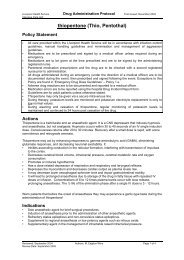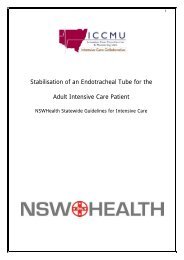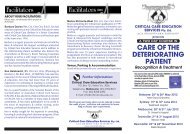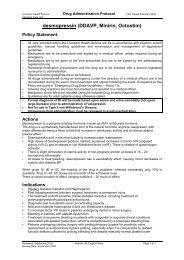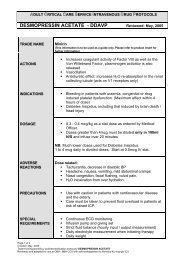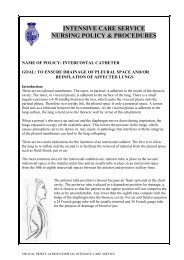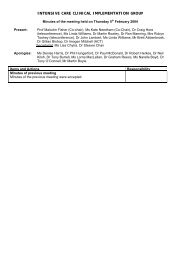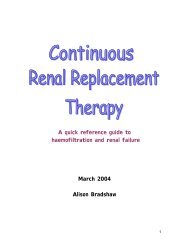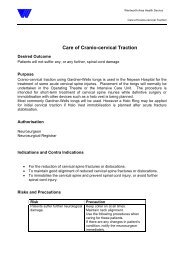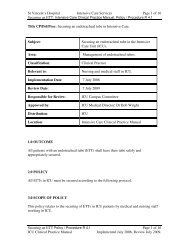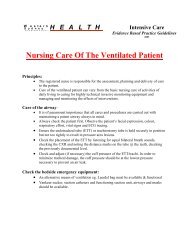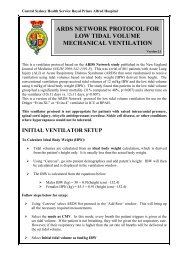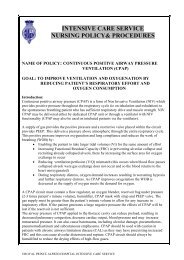Care_of_mechanically_ventilated patient (RPA) - Intensive Care ...
Care_of_mechanically_ventilated patient (RPA) - Intensive Care ...
Care_of_mechanically_ventilated patient (RPA) - Intensive Care ...
You also want an ePaper? Increase the reach of your titles
YUMPU automatically turns print PDFs into web optimized ePapers that Google loves.
INTENSIVE CARE SERVICE<br />
NURSING POLICY & PROCEDURES<br />
NAME OF POLICY: CARE OF THE MECHANICALLY VENTILATED<br />
PATIENT<br />
GOAL: TO PROVIDE PATIENT SAFETY AND COMFORT WHILE<br />
MECHANICALLY VENTILATED<br />
Introduction:<br />
Mechanical ventilation is initiated for various reasons such as:<br />
� Acute lung injury<br />
� Airway management, and<br />
� Surgical intervention.<br />
The ETT (nasal or oral) may be left insitu for up to 10 days after which, the <strong>patient</strong> will be<br />
considered for a tracheostomy, if mechanical ventilation is to be continued (see care <strong>of</strong> the<br />
tracheostomy)<br />
Nursing Responsibilities:<br />
� Check ventilator setting, they should correspond to Medical Officer’s orders on “<strong>Care</strong>vue”<br />
� Ensure <strong>patient</strong> is not left unattended (if assisting with another <strong>patient</strong>, ensure <strong>patient</strong> is<br />
observed) and alarm parameters are set appropriately on the ventilator<br />
� Check emergency equipment is present and in working order:<br />
� Air-viva<br />
� Black bag and mask<br />
� Oxygen tubing attached to oxygen outlet<br />
� Full portable oxygen cylinder<br />
� 20ml syringe and dwellcath on top <strong>of</strong> the ventilator<br />
� Yanker sucker attached to suction apparatus<br />
� PEEP valve on appropriate Air-viva/black bag (if <strong>patient</strong> is on PEEP<br />
> 5cmH2O)<br />
� Assess baseline respiratory status and record under “Initial Assessment”:<br />
� Rate and depth <strong>of</strong> breathing<br />
� Osculate chest wall for breath sounds<br />
� Assess chest wall for asymmetry<br />
� Assess saturation levels<br />
� Review last ABG<br />
� Assess ETT position:<br />
� Check black numerical markings on the ETT, should correspond to initial<br />
documented tube position. If upward or downward migration has occurred<br />
inform Medical Officer prior to any adjustment<br />
©ROYAL PRINCE ALFRED HOSPITAL INTENSIVE CARE SERVICE
� Ensure ETT is secured using the ‘bow’ method demonstrated on ETT Tying<br />
poster<br />
� Portable Chest X-ray:<br />
� Inform the <strong>patient</strong> <strong>of</strong> the procedure and support where necessary<br />
� Assist and direct the radiographers<br />
� Where possible and applicable sit <strong>patient</strong> up for a chest X-ray<br />
� When X-rays are taken ensure all indwelling tubes and lines are<br />
moved <strong>of</strong>f the chest wall<br />
� When moving <strong>patient</strong>s for procedures ensure ETT is protected at all<br />
times<br />
� Protect reproductive organs on females and males <strong>of</strong> child bearing<br />
years<br />
� Protect yourself by standing at least 7 feet away from X-ray<br />
� Ensure all immediate staff in the vicinity are aware <strong>of</strong> X-rays being<br />
taken (usually the responsibility <strong>of</strong> the radiographer)<br />
� Assess pulmonary lung fields in comparison with previous X-ray and<br />
position <strong>of</strong> ETT<br />
� General <strong>Care</strong>:<br />
� Patient to be nursed, unless contraindicated e.g. acute haemodynamic<br />
instability, with the head <strong>of</strong> the bed elevated at least 30 o to minimise<br />
risk <strong>of</strong> nosocomial pneumonias (ruler to be used to ensure accuracy).<br />
In the event <strong>of</strong> IABP and spinal cord injury, <strong>patient</strong>s can be nursed<br />
with the bed tilted to 30 o as tolerated.<br />
� Titrate <strong>patient</strong> ventilation in response to ABG in conjunction with<br />
Medical Officer’s parameter (eg. maintain saturation >95%, Arterial<br />
oxygen >65mmHg, Carbon dioxide no greater than 50mmHg) and/or<br />
in consultation with Intensivist<br />
� Obtain an ABG as clinically indicated, SaO2 monitoring should be<br />
used as first line indicator <strong>of</strong> ventilation and ABG’s used to assess<br />
CO2 and pH when required. ABG sampling is not necessary after<br />
changing ventilation settings if saturation levels are unchanged.<br />
� Check cuff pressure is at appropriate pressure to maintain seal (see<br />
separate policy)<br />
� Assess water humidification level and the set temperature is<br />
maintained<br />
� Provide adequate sedation as prescribed<br />
� Change inline suction catheter every 72hrs, ensuring to keep catheter<br />
clear <strong>of</strong> secretions with regular flushes post suctioning.<br />
� Maintain oral hygiene<br />
� Ensure lips are moist (apply Vaseline)<br />
� Avoid pressure from ETT on the lips (change ETT position form one<br />
side <strong>of</strong> the mouth to the other during daily/PRN tape changes if<br />
necessary)<br />
� Ensure adequate pulmonary toileting (suction 4-6/24hr & PRN)<br />
� Observe <strong>patient</strong> for Respiratory/haemodynamic compromise during<br />
physiotherapy treatment<br />
� Aspirate NG tube 4-6/24hr until entral feeding is successfully<br />
established (see separate policy)<br />
©ROYAL PRINCE ALFRED HOSPITAL INTENSIVE CARE SERVICE
� Positioning an Intubated Patient:<br />
� ICU <strong>patient</strong>s must be repositioned every 2-3/24 to observe pressure<br />
areas and relieve pressure on the pressure points, turning is also<br />
essential for chest physiotherapy (even when using pressure relieving<br />
mattress’s)<br />
� Prior to turning a <strong>patient</strong> ensure that the ETT is secure, the ties may<br />
need to be retied if they are loose.<br />
� Turning is always performed with at least two staff members. Ideally<br />
one person should be specifically responsible for the ETT and IV<br />
lines.<br />
� When performing a turn ensure the task <strong>of</strong> protecting the airway is<br />
delegated and the person knows that they must be able to visualise the<br />
ETT at all times<br />
� On completion <strong>of</strong> the turn adjust the ventilator tubing so that there<br />
isn’t tension pulling down on the ETT<br />
� Barotrauma:<br />
� Be alert to changes in peak inspiratory pressure (PIP)<br />
� Observe for signs <strong>of</strong> a Pneumothorax<br />
� subcutaneous emphysema<br />
� decrease tidal volume (leak)<br />
� decrease in oxygen saturation percentage<br />
� distress <strong>patient</strong><br />
Ventilation tube change:<br />
If the <strong>patient</strong> is to unstable haemodynamically and/or respiratory, check with Intensivist before<br />
this procedure<br />
� All tubing from the ventilator up to the “blue” connector <strong>of</strong> the ETT is to be changed,<br />
every 7 days<br />
� When tubing is change a ventilation “safety check” is also initiated<br />
� Air-viva, black bag, oxygen tubing and PEEP valve and water humidification (if<br />
applicable) is changed every 7 days<br />
� Record change on careplan<br />
ETT placement Portable chest X-ray<br />
©ROYAL PRINCE ALFRED HOSPITAL INTENSIVE CARE SERVICE
REFERENCES:<br />
Bucher, L & Melander, S. (1999). Critical <strong>Care</strong> Nursing. W. B. Saunders Company, Philadelphia<br />
Marino, P.L (1991) The ICU book. Lea & Febiger, Philadelphia<br />
Occupational Health and Safety: Universal precautions taken in the preparation, administration <strong>of</strong> drug and<br />
disposal <strong>of</strong> equipment and sharps.<br />
Cross Referenced: <strong>RPA</strong>H Occ. Health & Safety Manual and Infection Control Manual<br />
NSW Infection Control Policy 98/99<br />
Revised by: Frankie Hopkins (ACNC) & Chanelle Innes (CNC) April 2002<br />
Reviewed by: Marjorie Kinghan (CNE)<br />
Authorised by: Dr. Paul Phipps (Intensivist)<br />
Revision March 2004<br />
With the introduction <strong>of</strong> Powerchart online ordering, a clinical agreement has been set up with the Director<br />
<strong>of</strong> ICS and other Staff Specialists. Nursing Management, with the agreement <strong>of</strong> the hospital executive, have<br />
made arrangement that allows all permanently employed <strong>RPA</strong>H Nursing Staff to place orders for a variety <strong>of</strong><br />
tests on their behalf. It is a Health Insurance Commission (HIC) directive that all orders placed by nursing<br />
staff are countersigned by the responsible MO within 14 days.<br />
©ROYAL PRINCE ALFRED HOSPITAL INTENSIVE CARE SERVICE




